-
Spread Windows Forms Product Documentation
- Getting Started
-
Developer's Guide
- Understanding the Product
- Working with the Component
-
Spreadsheet Objects
- Understanding Parts of the Component
- Object Parentage
- Resetting Parts of the Interface
- Rich Text Editing
- Improving Performance by Suspending the Layout
- Ways to Improve Performance
- Allowing User Functionality
- Allowing the User to Zoom the Display of the Component
- Working with Scroll Bars
- Adding a Status Bar
- Customizing Viewports
- Customizing Split Boxes
- Working With Slicers
- Working with Built-In Dialogs
- Ribbon Control
- Sheets
- Rows and Columns
- Headers
- Cells
- Cell Types
- Data Binding
- Customizing the Sheet Appearance
- Customizing Interaction in Cells
- Tables
- Understanding the Underlying Models
- Customizing Row or Column Interaction
- Formulas in Cells
- Sparklines
- Keyboard Interaction
- Events from User Actions
- File Operations
- Storing Excel Summary and View
- Printing
- Chart Control
- Customizing Drawing
- Touch Support with the Component
- Spread Designer Guide
- Assembly Reference
- Import and Export Reference
- Version Comparison Reference
Working with Built-In Dialogs
The Spread Designer provides a number of built-in dialogs that enable users to add data tables, format cells, insert functions, create forecast sheets, remove duplicates, add fill effects, etc.
You can invoke the built-in dialogs at runtime by calling the methods of the BuiltInDialogs class of the FarPoint.Win.Spread.Dialogs namespace, as discussed below.
Data Table Dialog
The Data Table dialog, you can prompt the user to enter the desired row or column input cells at run-time to create a data table in the Spread worksheet. The BuiltInDialogs class provides the DataTable method to invoke the DataTable dialog at runtime.
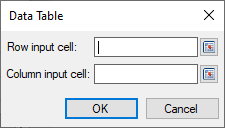
The following example code shows how to use the DataTable method to call the Data Table dialog at runtime:
FarPoint.Win.Spread.Dialogs.BuiltInDialogs.DataTable(fpSpread1).Show(fpSpread1);FarPoint.Win.Spread.Dialogs.BuiltInDialogs.DataTable(FpSpread1).Show(FpSpread1)For more information on data tables, see DataTable topic.
Fill Effects Dialog
You can add fill effects like color gradients and pattern to a shape using the Fill Effects dialog, which provides options like colors, variants, shading styles, patterns, and a sample preview to view the gradient effect. You can invoke the dialog using the FillEffects method of the BuiltInDialogs class.
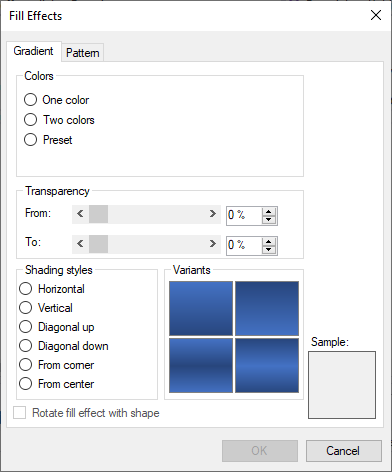
The following example code shows how to call the Fill Effects dialog box at runtime:
FpSpread1.Features.EnhancedShapeEngine = true;
IShape shape1 = FpSpread1.AsWorkbook.ActiveSheet.Shapes.AddShape(AutoShapeType.Rectangle, 50, 100, 100, 200);
FarPoint.Win.Spread.Dialogs.BuiltInDialogs.FillEffects(FpSpread1.AsWorkbook(), ((Shape)shape1).Brush, Color.FromArgb(255, 255, 255), Color.FromArgb(0, 0, 0)).ShowDialog();FpSpread1.Features.EnhancedShapeEngine = True
Dim shape1 As IShape = FpSpread1.AsWorkbook.ActiveSheet.Shapes.AddShape(AutoShapeType.Rectangle, 50, 100, 100, 200)
FarPoint.Win.Spread.Dialogs.BuiltInDialogs.FillEffects(FpSpread1.AsWorkbook(), CType(shape1, Shape).Brush, Color.FromArgb(255, 255, 255), Color.FromArgb(0, 0, 0)).ShowDialog()For more information on fill effects in shapes, see Gradient Fill Effects topic.
Create Forecast Worksheet Dialog
The BuiltInDialogs class provides the ForecastSheet method to create a Forecast Sheet dialog that allows to create a new worksheet that predicts data trends.
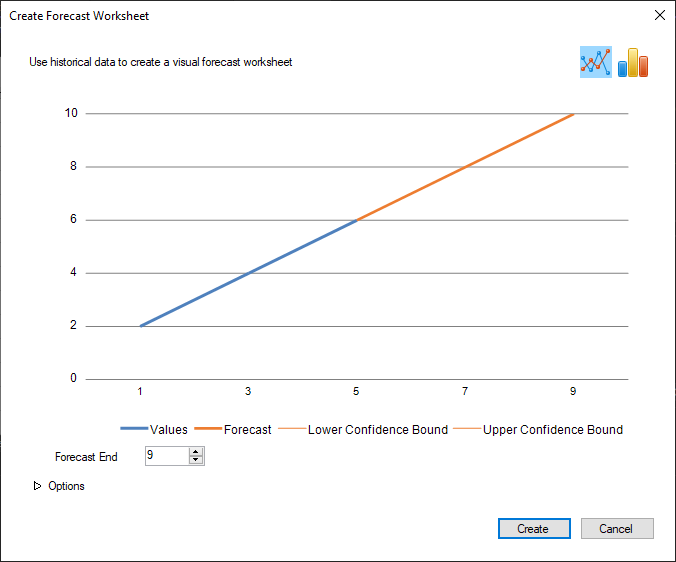
The following example code shows how to call the Forecast Sheet dialog box at runtime:
IWorksheet sheet = fpSpread1.AsWorkbook().ActiveSheet;
sheet.SetClip(0, 0, 3, 1, "1\n3\n5");
sheet.SetClip(0, 1, 3, 1, "2\n4\n6");
sheet.Cells["A1:B3"].Select();
FarPoint.Win.Spread.Dialogs.BuiltInDialogs.ForecastSheet(fpSpread1).Show(fpSpread1);IWorksheet sheet = FpSpread1.AsWorkbook().ActiveSheet
sheet.SetClip(0, 0, 3, 1, "1" & vbCrLf & "3" & vbCrLf & "5")
sheet.SetClip(0, 1, 3, 1, "2" & vbCrLf & "4" & vbCrLf & "6")
sheet.Cells("A1:B3").Select()
FarPoint.Win.Spread.Dialogs.BuiltInDialogs.ForecastSheet(FpSpread1).Show(FpSpread1)For more information about ForeCast feature, see Forecast Sheet topic.
Format Cells Dialog
The Format Cells dialog allows the user to customize the style settings of the specified range. The BuiltInDialogs class provides the FormatCells method to invoke this dialog at runtime.
The FormatCells method has two overloads, FormatCells(GrapeCity.Spreadsheet.IRange cells, [FarPoint.Win.Spread.FormatCells.FormatCellsTab activeTab = 0]) and FormatCells(FarPoint.Win.Spread.CellType.IRichTextEditor richTextEditor).
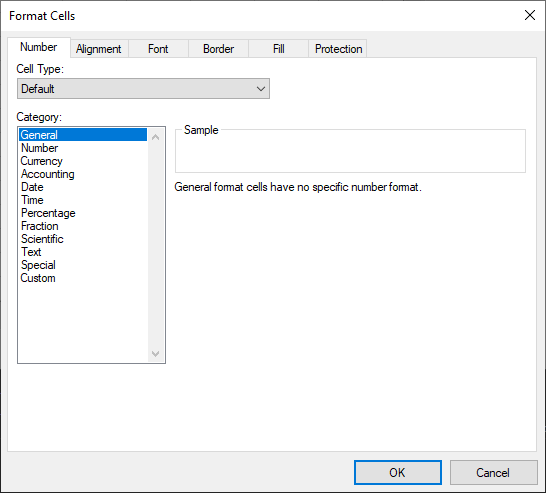
The following example code shows how to call the Format Cells dialog box to manipulate the style settings in the cell range using the FormatCells(GrapeCity.Spreadsheet.IRange cells, [FarPoint.Win.Spread.FormatCells.FormatCellsTab activeTab = 0]) method.
IWorksheet sheet = fpSpread1.AsWorkbook().ActiveSheet;
FarPoint.Win.Spread.Dialogs.BuiltInDialogs.FormatCells(sheet.Cells["A1:B1"]).ShowDialog();IWorksheet sheet = FpSpread1.AsWorkbook().ActiveSheet
FarPoint.Win.Spread.Dialogs.BuiltInDialogs.FormatCells(sheet.Cells("A1:B1")).ShowDialog()For more information on formatting cells, refer to Cell Format topic.
The FormatCells(FarPoint.Win.Spread.CellType.IRichTextEditor richTextEditor) method allows the user to format and edit the rich text in cells at run-time.
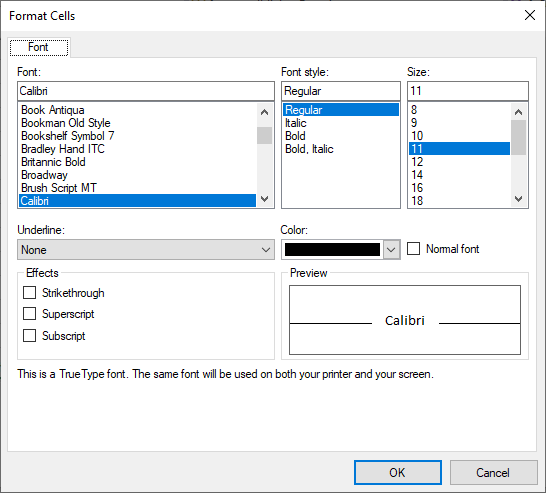
The following example code shows how to invoke the Format Cells dialog box for rich text editing:
fpSpread1.Features.RichTextEdit = RichTextEditMode.On;
IWorksheet sheet = fpSpread1.AsWorkbook().ActiveSheet;
sheet.Cells["A1"].Value = "abc";
private void fpSpread1_EditModeOn(object sender, EventArgs e)
{
if (fpSpread1.EditingControl is IRichTextEditor richTextEditor)
{
FarPoint.Win.Spread.Dialogs.BuiltInDialogs.FormatCells(richTextEditor);
}
}fpSpread1.Features.RichTextEdit = RichTextEditMode.On
IWorksheet sheet = FpSpread1.AsWorkbook().ActiveSheet
sheet.Cells("A1").Value = "abc"
Private Sub FpSpread1_EditModeOn(sender As Object, e As EventArgs)
If TypeOf FpSpread1.EditingControl Is IRichTextEditor Then
Dim richTextEditor As IRichTextEditor = CType(FpSpread1.EditingControl, IRichTextEditor)
FarPoint.Win.Spread.Dialogs.BuiltInDialogs.FormatCells(richTextEditor).ShowDialog()
End If
End SubTo learn about rich text editing in Spread, see Rich Text Editor topic.
Goal Seek Dialog
The Goal Seek dialog allows the user to calculate the values necessary to achieve a specific goal in the Spread worksheet. For this purpose, the BuiltInDialogs class provides the GoalSeek method.
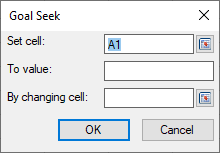
The following example code shows how to call the Goal Seek dialog at runtime:
IWorksheet sheet = fpSpread1.AsWorkbook().ActiveSheet;
sheet.Cells["B1"].Formula = "A1";
sheet.Cells["B2"].Formula = "A2";
FarPoint.Win.Spread.Dialogs.BuiltInDialogs.GoalSeek(fpSpread1).Show(fpSpread1);IWorksheet sheet = FpSpread1.AsWorkbook().ActiveSheet
sheet.Cells("B1").Formula = "A1"
sheet.Cells("B2").Formula = "A2"
FarPoint.Win.Spread.Dialogs.BuiltInDialogs.GoalSeek(FpSpread1).Show(FpSpread1)To learn in detail about the Goal Seek feature, see Goal Seek topic.
Colors Dialog
The Colors dialog allows users to choose customized colors in Spread. It lets you choose between standard and custom colors at runtime. The BuiltInDialogs class provides the MoreColors method for this purpose.
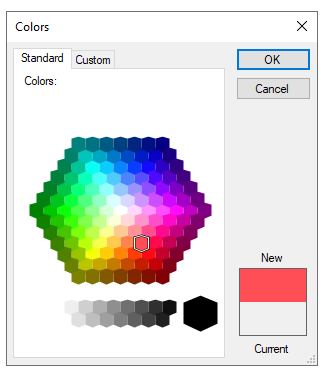
The following example code shows how to call the Colors dialog box using MoreColors method at runtime.
IWorkbook activeWorkbook = fpSpread1.AsWorkbook();
IRange range = activeWorkbook.ActiveSheet.ActiveCell;
FarPoint.Win.Spread.Dialogs.MoreColors colorDlg = FarPoint.Win.Spread.Dialogs.BuiltInDialogs.MoreColors(range.Font.Color, activeWorkbook);
if (colorDlg.ShowDialog() == DialogResult.OK)
{
range.Interior.Color = colorDlg.Color;
}
else
{
colorDlg.Dispose();
return;
}Dim activeWorkbook As IWorkbook = FpSpread1.AsWorkbook()
Dim range As IRange = activeWorkbook.ActiveSheet.ActiveCell
Dim colorDlg As FarPoint.Win.Spread.Dialogs.MoreColors = FarPoint.Win.Spread.Dialogs.BuiltInDialogs.MoreColors(range.Font.Color, activeWorkbook)
If colorDlg.ShowDialog() = DialogResult.OK Then
range.Interior.Color = colorDlg.Color
Else
colorDlg.Dispose()
Return
End IfName Manager Dialog
The Name Manager dialog lets you create, edit, or delete custom names in the Spread Designer. The BuiltInDialogs class provides the NameManager method to invoke the Name Manager dialog at runtime.
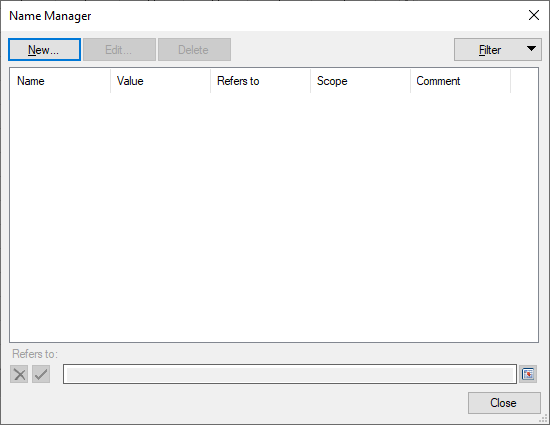
The following example code shows how to call the Name Manager dialog at runtime:
FarPoint.Win.Spread.Dialogs.BuiltInDialogs.NameManager(fpSpread1).Show(fpSpread1);FarPoint.Win.Spread.Dialogs.BuiltInDialogs.NameManager(FpSpread1).Show(FpSpread1)For more information, see Name Manager Dialog topic.
New Name Dialog
The New Name dialog allows users to create new defined names in Spread. You can create names for cell ranges, choose whether a name should be accessible within an workbook or an individual worksheet only, and also add comments, if necessary. The BuiltInDialogs class provides the NewName method to invoke this dialog at runtime.
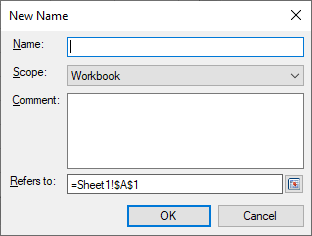
The following example code shows how to call the New Name dialog box:
FarPoint.Win.Spread.Dialogs.BuiltInDialogs.NewName(fpSpread1).Show(fpSpread1);FarPoint.Win.Spread.Dialogs.BuiltInDialogs.NewName(FpSpread1).Show(FpSpread1)Remove Duplicates Dialog
The Remove Duplicates dialog allows the user to remove duplicate values from a range of values. Spread allows you to invoke this dialog at runtime. For this purpose, the BuiltInDialog class provides the RemoveDuplicates method.
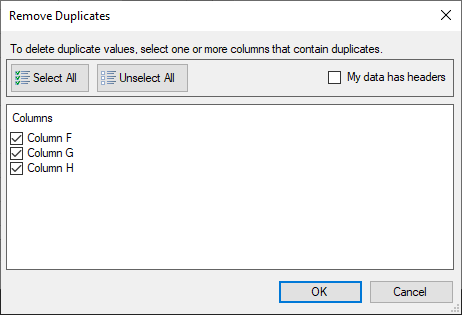
The following example code shows how to call the Remove Duplicates dialog at runtime:
fpSpread1.ActiveSheet.SetClip(0, 1, 6, 1, "2\n1\n3\n2\n5\n3");
ActiveSheet.Cells["B1:B8"].Select();
FarPoint.Win.Spread.Dialogs.BuiltInDialogs.RemoveDuplicates(fpSpread1).ShowDialog(fpSpread1);FpSpread1.ActiveSheet.SetClip(0, 1, 6, 1, "2" & vbCrLf & "1" & vbCrLf & "3" & vbCrLf & "2" & vbCrLf & "5" & vbCrLf & "3")
ActiveSheet.Cells("B1:B8").Select()
Dim removeDuplicatesDialog As FarPoint.Win.Spread.Dialogs.RemoveDuplicatesDialog = FarPoint.Win.Spread.Dialogs.BuiltInDialogs.RemoveDuplicates(FpSpread1)
If removeDuplicatesDialog IsNot Nothing Then
removeDuplicatesDialog.ShowDialog(FpSpread1)
End IfFor more information about removing duplicates in Spread, see Removes Duplicates topic.
Convert Text To Columns Wizard Dialog
The Convert Text To Columns Wizard dialog lets you parse the text from one cell or column into multiple columns using a delimiter. The BuiltInDialogs class provides the TextToColumns method to invoke this dialog at runtime.
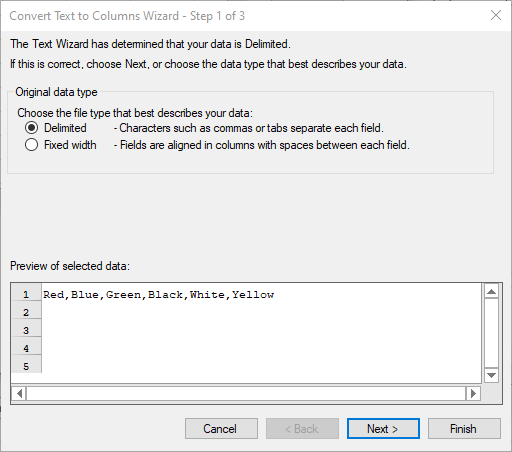
The following example code shows how to call the Convert Text To Columns Wizard dialog at runtime.
IWorksheet sheet = fpSpread1.AsWorkbook().ActiveSheet;
sheet.Cells["A1"].Value = "Red,Blue,Green,Black,White,Yellow";
FarPoint.Win.Spread.Dialogs.BuiltInDialogs.TextToColumns(fpSpread1).Show(fpSpread1);IWorksheet sheet = FpSpread1.AsWorkbook().ActiveSheet
sheet.Cells("A1").Value = "Red,Blue,Green,Black,White,Yellow"
FarPoint.Win.Spread.Dialogs.BuiltInDialogs.TextToColumns(FpSpread1).Show(FpSpread1)For more information about the feature, see Text to Columns topic.
Insert Function Dialog
Users can call the Insert Function dialog at runtime using the ToggleInsertFunction method of the BuiltInDialogs class. The Insert Function dialog lets you search and select functions, and insert them in cells.
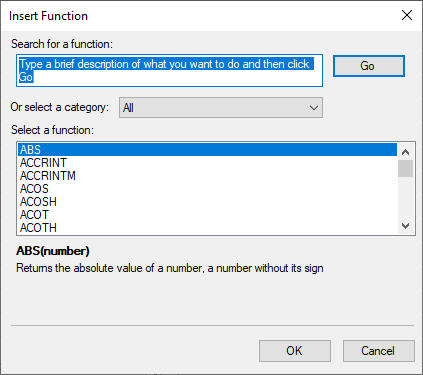
The following example code shows how to invoke the Insert Function dialog:
FarPoint.Win.Spread.Dialogs.BuiltInDialogs.ToggleInsertFunction(fpSpread1);FarPoint.Win.Spread.Dialogs.BuiltInDialogs.ToggleInsertFunction(FpSpread1)To learn more about Insert Functions, see Insert Function Dialog.
Cell Type Dialog
The Cell Type dialog allows users to customize settings for a particular cell type, such as General, Number, Currency, Date, etc. The setting options can be different depending on the selected cell type.
The BuiltInDialogs class provides the CellTypes method to invoke this dialog at runtime.
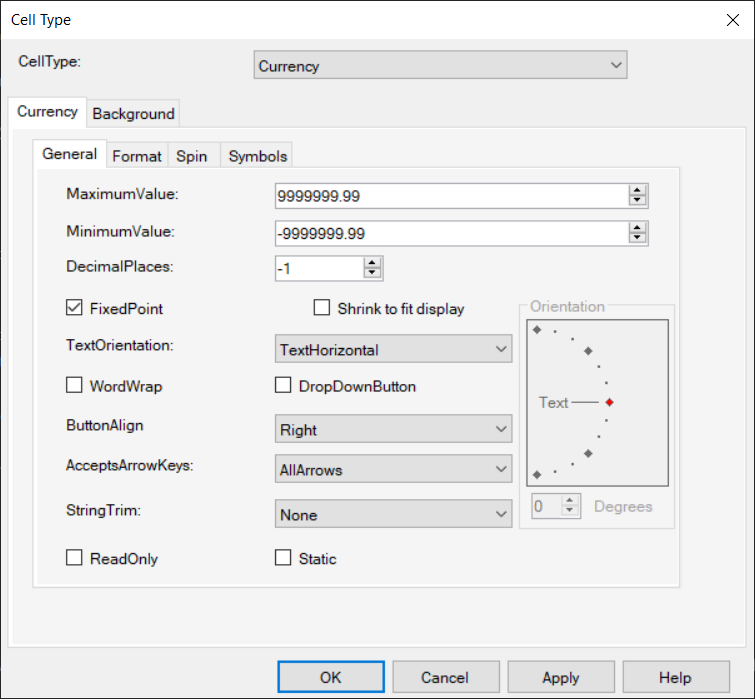
The following example code shows how to call the Cell Type dialog at runtime.
FarPoint.Win.Spread.CellType.CurrencyCellType currcell = new FarPoint.Win.Spread.CellType.CurrencyCellType();
FarPoint.Win.Spread.Dialogs.BuiltInDialogs.CellTypes(fpSpread1, currcell).ShowDialog();Dim currcell As FarPoint.Win.Spread.CellType.CurrencyCellType = New FarPoint.Win.Spread.CellType.CurrencyCellType()
FarPoint.Win.Spread.Dialogs.BuiltInDialogs.CellTypes(FpSpread1, currcell).ShowDialog()For more information about the feature, see Cell Type Dialog topic.


